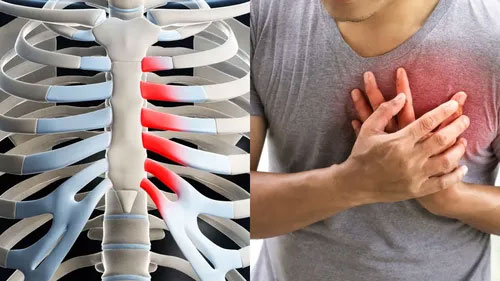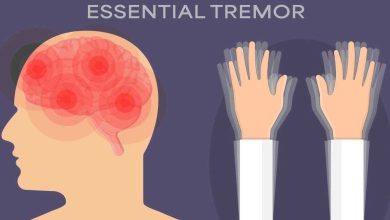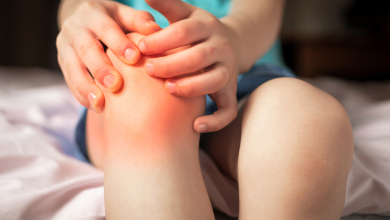Costochondritis Symptoms, Causes, Diagnosis and Treatment

What is Costochondritis?
Costochondritis is painful inflammation in the cartilage that connects your ribs to your breastbone (sternum).
Those sections of cartilage are your costochondral joints. They’re stiff and strong to help your ribcage protect organs like your heart and lungs.
The inflammation can make breathing or moving your chest very painful. The pain can start suddenly or develop slowly and spread (radiate) across your chest.
Some people assume that any chest pain is a sign of a heart attack. But the same issues that cause heart attacks don’t cause costochondritis, and having costochondritis doesn’t mean you’re having a heart attack. But you should always visit a healthcare provider if your chest or ribs hurt, especially if the pain doesn’t get better in a few days.
How common is costochondritis?
Costochondritis is one of the most common causes of chest pain. Experts estimate that around one-third of people who visit a healthcare provider with chest pain or rib pain have costochondritis.
What Are The Symptoms Of Costochondritis?
Chest pain is the most common costochondritis symptom.
What does costochondritis feel like?
Everyone experiences pain differently. Costochondritis usually feels like a low ache in your chest near your affected ribs. The pain might feel suddenly sharp or stabbing when you move your chest or torso. Some movements that can make costochondritis pain worse include:
- Breathing, especially taking deep breaths or breathing heavily.
- Coughing, sneezing or vomiting.
- Twisting your torso.
- Reaching overhead (like grabbing something off a high shelf).
- Hugging someone.
- Exercising.
- Lying down on your affected side.
What Causes Costochondritis?
Most instances of costochondritis tend to have no apparent reason. However, sometimes, the condition may be a consequent of:
- Strenuous exercise and weight lifting.
- Severe coughing.
- Blow to your chest.
- Specific health conditions such as rheumatoid arthritis and osteoarthritis.
- Joint infection such as tuberculosis.
- Cancerous and noncancerous tumors.
What Are The Risk Factors Of Costochondritis?
Following factors are identified for increasing the risks of costochondritis:
- According to the reports, women are more likely to develop costochondritis as compared to men.
- Individuals older than the age of forty are more diagnosed with costochondritis.
What Are The Complications Of Costochondritis?
The condition can be a signal towards other inflammatory diseases such as psoriatic arthritis, fibromyalgia and rheumatoid arthritis, which indeed require treatment.
What Are The Other Names Of Costochondritis?
Costochondritis is also known by the following names:
- Tietze’s disease.
- Chest wall pain.
- Costosternal chondrodynia.
- Costosternal syndrome.
How Costochondritis Is Diagnosed?
Diagnosing costochondritis is usually a diagnosis of elimination. This means a healthcare provider might do an exam and perform tests to rule out other, more serious conditions before diagnosing costochondritis.
Your provider will diagnose costochondritis with a physical exam.
They’ll feel your chest and ribs. They might press on your chest to feel how sensitive you are and to pinpoint where your pain is most intense (localized). They’ll examine your torso for other signs of injuries or conditions that might be causing your symptoms.
You might need a blood test to check for infections or other issues.
There’s no imaging test that can diagnose costochondritis. But your provider may use some imaging tests to rule out other causes of rib pain. The most common tests include:
- Chest X-ray.
- A computed tomography (CT) scan.
- Magnetic resonance imaging (MRI).
- Ultrasound.
- Electrocardiogram (EKG).
How Is Costochondritis Treated?
The most common costochondritis treatment is resting your chest and ribcage. Giving your irritated costochondral joints time to heal is the best thing to do for costochondritis.
Over-the-counter (OTC) medications like NSAIDs (nonsteroidal anti-inflammatory drugs) or acetaminophen can relieve your pain. Talk to your provider before taking pain medication for more than 10 days in a row.
It’s rare, but your provider might inject a corticosteroid into your affected joints to reduce the inflammation if your symptoms aren’t improving after a few weeks.
Some people with costochondritis get better without treatment, but don’t assume it’ll go away on its own. Visit your provider as soon as you notice any type of chest pain.
What can I expect if I have Costochondritis?
You should expect to make a full recovery from costochondritis. Once the inflammation heals, you should be able to return to all your usual activities with no long-term effects.
The worst part of costochondritis is usually the chest pain that makes people think they’re having issues with their hearts. Get new symptoms examined right away to rule out something more serious.
How long does Costochondritis last?
Costochondritis is usually a short-term issue. Most people experience symptoms anywhere from a few days to a few weeks. It’s rare, but costochondritis can last for several months.
Most people start to gradually feel better as they rest and take over-the-counter pain medications. Talk to your provider if your rib pain isn’t getting better in a few weeks after you start treating costochondritis.
There’s a chance that costochondritis comes back (recurs), even after it heals.
How can I prevent Costochondritis?
You might not be able to prevent costochondritis because experts aren’t certain what causes it.
In general, avoid putting too much stress on your chest and ribs. Make sure to rest after intense physical activity to give your body time to recover.
When should I see my healthcare provider?
Visit your provider right away if you notice any new symptoms or changes in or around your chest, especially new pain. Costochondritis usually isn’t dangerous, but it’s important to rule out other, more serious issues as soon as possible.
When should I go to the emergency room?
Call 911 (or your local emergency services phone number) or go to the ER if you think you’re experiencing heart attack symptoms, including:
- Shortness of breath (dyspnea) or trouble breathing.
- Nausea or stomach discomfort.
- Heart palpitations.
- A feeling of anxiety or “impending doom.“
- Sweating.
- Feeling lightheaded or dizzy.
Reference: https://my.clevelandclinic.org/health/diseases/22167-costochondritis
By : Natural Health News




